Getting tired of raking soggy leaves? Searching for the best leaf blowers? You can read this article, “The 6 Best Leaf Blowers of 2023,” on Linquip to find the item that suits your demands, as well as to gain an overview of this industrial equipment and to determine which item to choose.
With Linquip, you will be able to find plenty of information about leaf blowers which will assist you in making an informed decision. With Linquip, you can access some of the most powerful engines available right now on the market, so you can do your job more efficiently than ever before. More details about what Linquip can do for you can be found on our page “What Is a Debris Blower?“.
Considering purchasing a leaf blower in the near future? It is very easy to find the right equipment for your needs with Linquip’s extensive selection of Debris Blower Products. There may be many advantages to using the Linquip platform if you are interested in getting a quote for a leaf blower. By submitting your information to our simple online form, you will receive quotes from a number of Debris Blower Companies and Suppliers.
The task of manually raking leaves can be tedious. By using a leaf blower, the process will be easier and faster. From light-duty handheld units to heavyweight professional-grade models, leaf blowers come in a wide variety of styles and sizes. The following are the best leaf blowers, based on the reviews that have been left by their users.
The first thing you’ll discover in this article is a very basic description of leaf blowers as well as how you’ll be able to determine which one is best for you.

Basics of Leaf Blowers
Getting up on a fall day to use a leaf blower is a joy. Your favorite power tool makes you wish you had a larger yard so you could use it more frequently. Leaf blowers are available for rent, but who wants to deal with them? In addition, borrowing a noisy, old leaf blower from a neighbor can be like pulling teeth. A leaf blower that isn’t suitable for your lawn can make you want to rake the leaves that fell on it just to remove them.
While buying a leaf blower will cost more upfront than renting, you’ll save plenty of time and hassle since you won’t have to pick up and return it, and you won’t have to deal with a blower you dislike.
The effectiveness of a blower is not the only factor to consider. The noise level of your lawn equipment is also important to keep in mind if you want to be a good neighbor because some communities prohibit the use of certain types of leaf blowers. Check out these tips for finding the best leaf blower.
Leaf Blowers Buying Guide
If you want to find the best leaf blowers for your yard, make sure you have confidence in your own expertise. A leaf blower’s size, weight, power, and runtime can be considered when determining which products are the best. It is also important to keep in mind that additional features, like variable speed triggers, are great, but the leaf blower’s core functionality, which makes it so effective and reliable, is more crucial.
Types of Leaf Blowers
Leaf blowers come in several different types, classified according to their fuel type. Among these are:
- Gas-powered blowers
- Corded electric blowers
- Cordless blowers powered by batteries
Gas Leaf Blowers
The most powerful leaf blowers are usually gasoline-powered, and they’re best for properties larger than a quarter acre. In order to avoid breathing carbon monoxide and other pollutants, gas leaf blowers should always be used outdoors or in well-ventilated areas.
There are two-cycle and four-cycle engines available. The two-cycle engine combines oil and gasoline and offers a good balance of power and weight. A four-cycle engine runs on gasoline alone but tends to be heavier and requires regular oil changes.
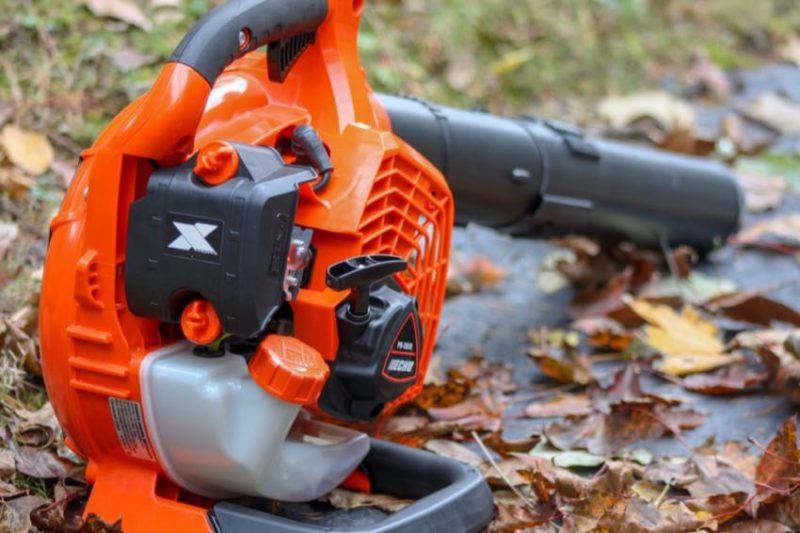
Corded Electric Leaf Blowers
The lightweight, portable, and quieter nature of corded electric units make them a better choice over gasoline-powered ones. Driveways, decks, and patios can be swept with light-duty electric sweepers, while large yards can be cleaned with higher-powered electric blowers.
With corded electric blowers, you can get steady power without having to carry batteries around. Because of the cord, these are primarily used in small yards or near homes.
Battery-Powered Electric Leaf Blowers
Battery-powered and cordless leaf blowers offer many of the same advantages as electric models, as well as excellent mobility. However, battery-powered leaf blowers are slightly heavier and require regular recharge due to their batteries.
Other power equipment or accessories, such as string trimmers, hedge trimmers, and chainsaws, can be used with cordless leaf blowers. You may want to keep some extra batteries in reserve for large lawns or multiple battery-powered tools, so the cordless leaf blower is always fully charged.
Size and Weight
While a larger model may have more power, it may also be more unwieldy. You should consider the weight of the blower as well.
A small, handheld leaf blower will suffice for a suburban lot with a few trees. The weight of a handheld leaf blower typically varies from 3 to 15 pounds, depending on whether it is gasoline-powered or electric. Compared to electric models, handheld gas blowers weigh about 6 to 8 pounds more. Small leaf blowers usually come with a shoulder strap as well.
If you have a large yard or many trees, a backpack-style model is ideal. Straps are provided with backpack leaf blowers to distribute the weight since the motors on these products are quite heavy. Backpack leaf blowers range in weight from 15 to 30 pounds.
Usually, professionals and people with heavy-duty requirements use wheeled, walk-behind blowers. A set of wheels is attached to these large leaf blowers. This machine is too heavy to carry, even when strapped to a backpack or attached to a harness. Most wheeled leaf blowers weigh between 50 and 100 pounds although some weigh as little as 20 pounds.
Power
- CFM: Cubic feet per minute (CFM) is a measurement of how much air is pushed through leaf blowers. The CFM of a blower typically ranges from 200 to 800. A high CFM rating of 500 to 800 can move significantly more leaves than a model with a lower CFM rating.
- mph: Air exits a blower at speed measured in miles per hour (mph), another indicator of its power. It refers to the blower’s capability to move a leaf over a longer distance rather than moving a lot of leaves at once. Leaf blowers usually have a speed rating of 100 to 250 mph.
- cc: For gasoline-powered leaf blowers, motor size is measured in cubic centimeters (cc), with bigger motors being able to displace more fuel and run at higher power. In corded electric blowers, amps (A) measure power output, whereas volts (V) measure power output in cordless, battery-powered blowers.
Using both CFM and mph is, however, a much simpler method than determining leaf blower power with cc, amps, or volts since CFM and mph are the same measurements among different types.
Runtime
For battery-powered leaf blowers, the runtime is a common metric. Gas-powered products also have a runtime, but manufacturers rarely provide this information since fuel mixtures and power output substantially influence the rate at which fuel is burned, whereas battery runtimes are relatively consistent.
In most cases, batteries last between 30 minutes and an hour, but if that’s all you’re concerned about, invest in spare batteries and chargers so you can always have a charged battery on hand.
Speed Settings
The primary leaf blower operates at a constant speed and airflow, producing a consistent CFM. A variety of speed settings have been added to leaf blowers by most manufacturers, which include variable speed triggers and speed control systems that enable a leaf blower to reach a certain speed and maintain that output like a cruise control system. In this way, you can blow leaves for an extended period of time without having to squeeze the trigger continually.
With the speed control, it is possible to increase the blower’s speed to its maximum CFM output when turning to large piles of leaves or moving clumps of wet leaves, lifting and pushing the leaves without any problems before lowering it back to the lower CFM level for the remainder of the yard. If you hold a trigger down for a long time, you may experience cramping or hand fatigue.
Noise
Noise is the most common complaint about leaf blowers. A gasoline-powered unit typically emits 90 to 102 decibels, while an electric or battery-powered model typically generates 65 to 78 decibels.
If you plan on buying a leaf blower, check to see if there are any local restrictions on noise. Some municipalities limit leaf blower noise to 65 or 70 decibels at a distance of 50 feet away.
The ability to adjust airflow and debris movement with variable speed settings can also help reduce noise. You should wear ear and eye protection while using a leaf blower, as well as a dust mask.
Accessories
A leaf blower’s capabilities can be enhanced by compatible accessories. Vacuum, shredding, or mulching attachments can be very useful. By shredding leaves, it reduces yard waste by using them as mulch in garden beds.
Vacuum-capable models often have larger-diameter chutes or tubes for collecting leaves. A blower with mulching capabilities can reduce the number of bags of leaves to one by a reduction ratio of 10:1 or 16:1.
Additional Features
After determining the type of leaf blower suitable for your needs and learning about its power capacity, run time, and speed settings, add extra features to your list. There is no need for these additions for the leaf blower to work properly, but they can make it easier for you to do your job. Detachable shoulder straps, oscillating nozzles, and trimmer kits are common features.
- Trimmer kit: The leaf blower trimmer kit is not strictly an add-on. Users can take care of yard maintenance in multiple ways with these kits, including a leaf blower and a grass trimmer.
- Oscillating nozzles: By using oscillating nozzles, a user can adjust the airflow length and concentration. Small clumps of wet leaves can be lifted from the ground with a precise burst of airflow using this tool.
- Detachable shoulder straps: With detachable shoulder straps, it is easier to operate the leaf blower, and the user can adjust the size of the straps to make it comfortable for anyone, regardless of their height.
Price
Budget leaf blowers will take care of sidewalks and moderate-sized yards. Oftentimes, you’ll find deals on models that have useful features like mulching and vacuuming. Be prepared for lower CFM rates, which might mean longer blowing times.
Best Snow Blowers Reviews
We won’t keep you waiting any longer. Based on buyer reviews, this section introduces the top 6 leaf blowers available on the market in terms of the above criteria.
1. WORX WG520 12 Amp TURBINE 600 Electric Leaf Blower
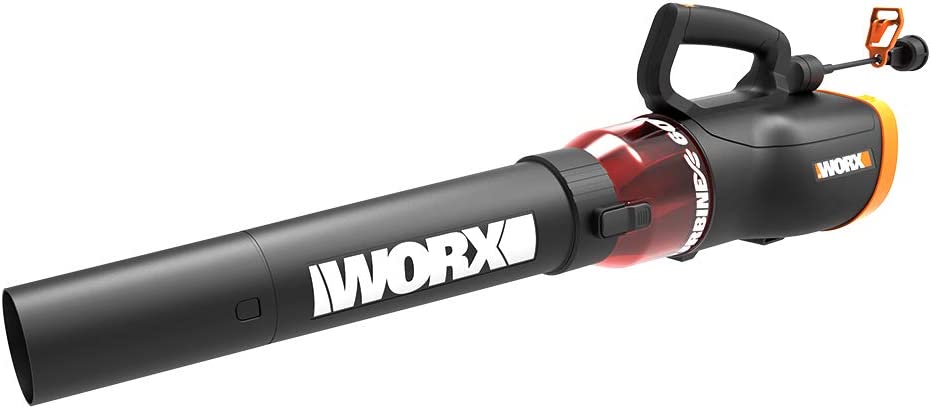
Specifications
| Item Weight | 3.27 Pounds |
| Power Source | Corded Electric |
| Speed | 110 Miles per Hour |
| Air Flow Capacity | 600 Cubic Feet Per Minute |
| Product Dimensions | 40 x 11 x 9.6 inches |
With its 600 cubic feet of air per minute rating, this leaf blower claims to be one of the highest CFM on our list. The Worx WG520 provides unmatched power to collect wet, matted leaves from pavements and other surfaces from a distance.
There is a speed dial on the Worx so that you can adjust the intensity of its blasts from hurricane-pounding to leaf-blower levels if you don’t intend to blow your potted plants off the porch.
Carrying the Worx WG520 is easy thanks to its 7.2-pound weight. At its highest speed, the Worx can emit 82 decibels, which is loud for a corded pick. When you use this blower, be sure to wear ear protection because the noise is higher than gasoline-powered blowers used by landscapers.
2. DEWALT Leaf Blower (DWBL700)
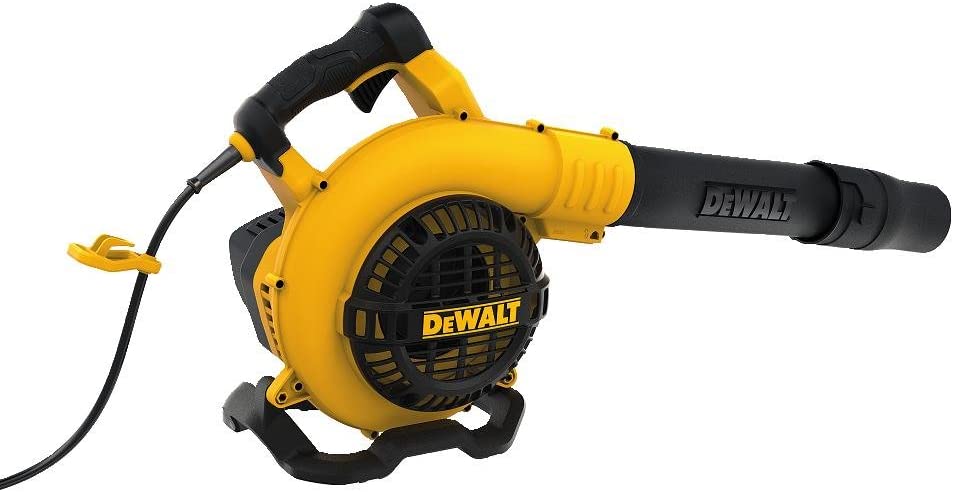
Specifications
| Item Weight | 9.8 Pounds |
| Power Source | Corded Electric, Air Powered, Manual |
| Speed | 145 Miles per Hour |
| Air Flow Capacity | 409 Cubic Feet Per Minute |
| Product Dimensions | 17 x 17 x 11 inches |
If you own this contractor-grade leaf blower, you will not need to carry around that business card anymore. With a power input of 12 amps and a blowing speed of up to 189 MPH, the DeWalt leaf blower is a professional-grade blower with top-of-the-line performance and convenience.
There is a one-inch nozzle included with the kit, which can be used for cleaning small crevices and spaces, and a flat concentrator nozzle that can be used for blowing away heavier debris. As it runs on electricity, you do not have to worry about having to refill it with gas, which is one of the advantages.
The only thing you might want to consider is buying more power cords so that you can vacuum up leaves in case you have a large yard and the vacuum doesn’t have vacuum capabilities for removing them. The device has a variable speed trigger that gives you the option to customize the airflow according to your needs.
3. EGO Power+ LB7654 Leaf Blower
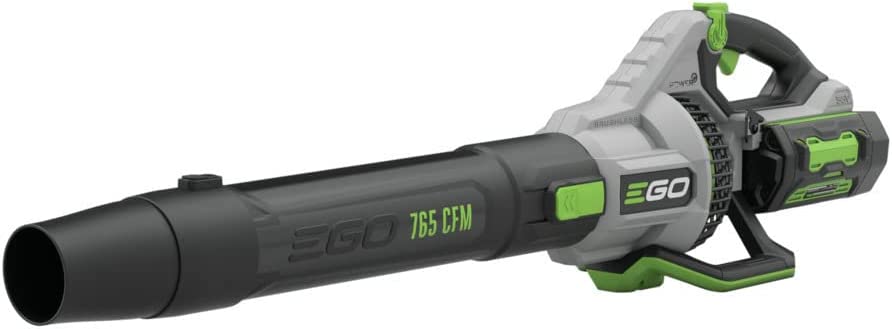
Specifications
| Item Weight | 15.77 Pounds |
| Power Source | DC |
| Speed | 200 Miles per Hour |
| Air Flow Capacity | 765 Cubic Feet Per Minute |
| Product Dimensions | 35.7 x 7.3 x 10.2 inches |
Ego Power+ LB7654 is the best cordless blower for getting to the back corners of your yard. As soon as you press the Thrust button on this battery-powered leaf blower, you will experience the air being moved at 765 cubic feet per minute.
A user-friendly design places buttons where hands naturally rest. An easy-to-use tab makes it easy to control the speed with one hand. The power is ample to accomplish a variety of yard tasks.
When used correctly, the Thrust power button proved most effective at removing large, embedded piles of leaves. However, it can also remove most of your mulch if you aren’t careful. A large yard doesn’t require any more power than this.
As soon as the battery is attached, the Ego LB7654 feels very balanced. It has a motor that is located in the center of the blower, protected from pant legs and windbreakers. A well-thought-out and streamlined design is evident.
Battery size is the only drawback of its design. It weighs 9.6 pounds when the battery is attached. Straps are not provided with the blower although there are hooks on the blower for them. It would be a chore to carry this blower around the yard.
On the lowest setting, the Ego registered 86 decibels, making it the loudest yard tool. If there is more space between houses in a larger yard, this machine is ideal.
4. Sun Joe SBJ597E-SJB Electric Leaf Blower
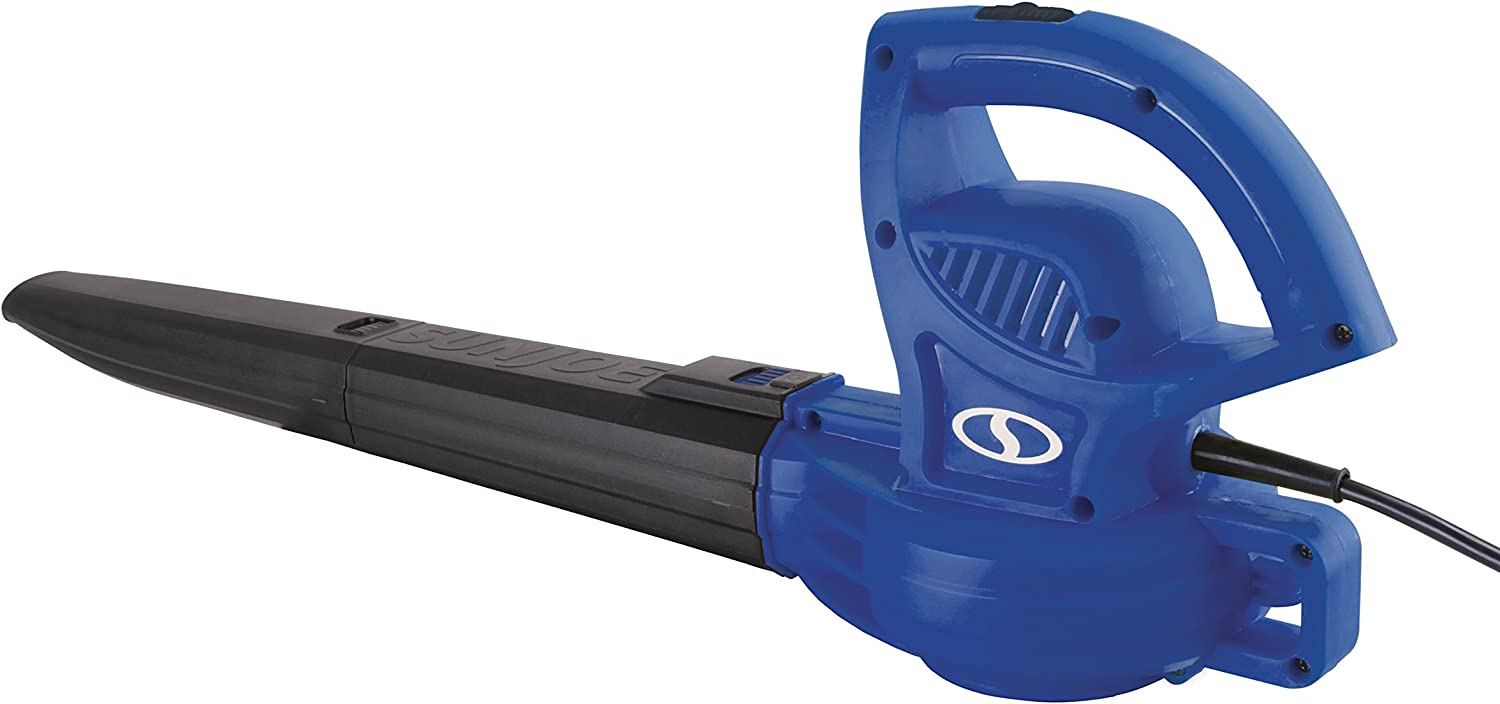
Specifications
| Item Weight | 3.9 Pounds |
| Power Source | Plug in |
| Speed | 155 Miles per Hour |
| Air Flow Capacity | 260 Cubic Feet Per Minute |
| Product Dimensions | 32 x 8 x 8 inches |
With an airspeed of up to 155 mph, the Sun Joe electric leaf blower is capable of effectively removing leaves and small twigs from driveways and walks. On hard surfaces, it performs similarly to larger, more powerful blowers although it isn’t quite as fast, and it lags somewhat on grassy surfaces. Only 3.9 pounds in weight, this single-speed blower is easy to handle.
This Sun Joe comes with a 6-amp motor and a short “pigtail” cord that should be plugged into a 50-foot 16-gauge exterior cord or a 100-foot 14-gauge extension cord. Because it has a short cord, the plug can be easily tied off for a secure connection.
With its powerful motor at a low price, the Sun Joe is ideal for removing grass clippings, leaves, and other light accumulations from garages, sidewalks, and garden areas.
5. Kobalt 40-Volt Lithium Ion (Li-ion) Medium-Duty Cordless Electric Leaf Blower
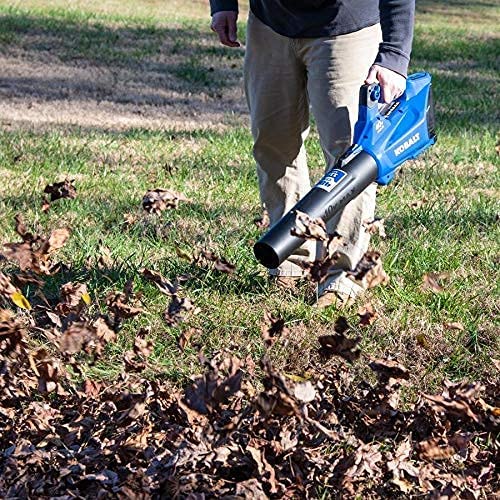
Specifications
| Item Weight | 7.43 Pounds |
| Power Source | Corded Electric, Battery Powered, Gas Powered |
| Speed | 110 Miles per Hour |
| Air Flow Capacity | 480 Cubic Feet Per Minute |
| Product Dimensions | 22 x 12 x 10 inches |
One of our top cordless blowers, the Kobalt KHB 3040-06, blows leaves and debris faster than most of the other cordless blowers, with an estimated output of 480 cubic feet per minute. As well as its variable-speed trigger, it is equipped with a turbo button for accelerating the power of the device in order to remove stubborn wet leaves.
As opposed to other cordless models, which are back-heavy due to the weight of the batteries, the Kobalt KHB 3040-06 feels well-balanced and easy to carry.
Even though the noise that this machine makes is not quiet, it sounds like a household vacuum cleaner, not a giant grinding machine. Kobalt representatives say that if measured at 50 feet, this leaf blower has an acoustic rating of under 65 decibels, which is in line with most laws pertaining to leaf blowers. This also means that it is a lot louder for the person who is operating it, which is why ear protection is important to prevent hearing loss.
One of the drawbacks of the Kobalt KHB 3040-06 is that it does not run for very long times. As reported by testers, after adjusting the blower power to the lowest setting, the Kobalt runs for a period of 16 minutes and 30 seconds. If you are planning to run your blower continuously for an extended period of time, it is a good idea to buy an additional battery to facilitate this.
6. Greenworks 40V Brushless Cordless Blower / Vacuum
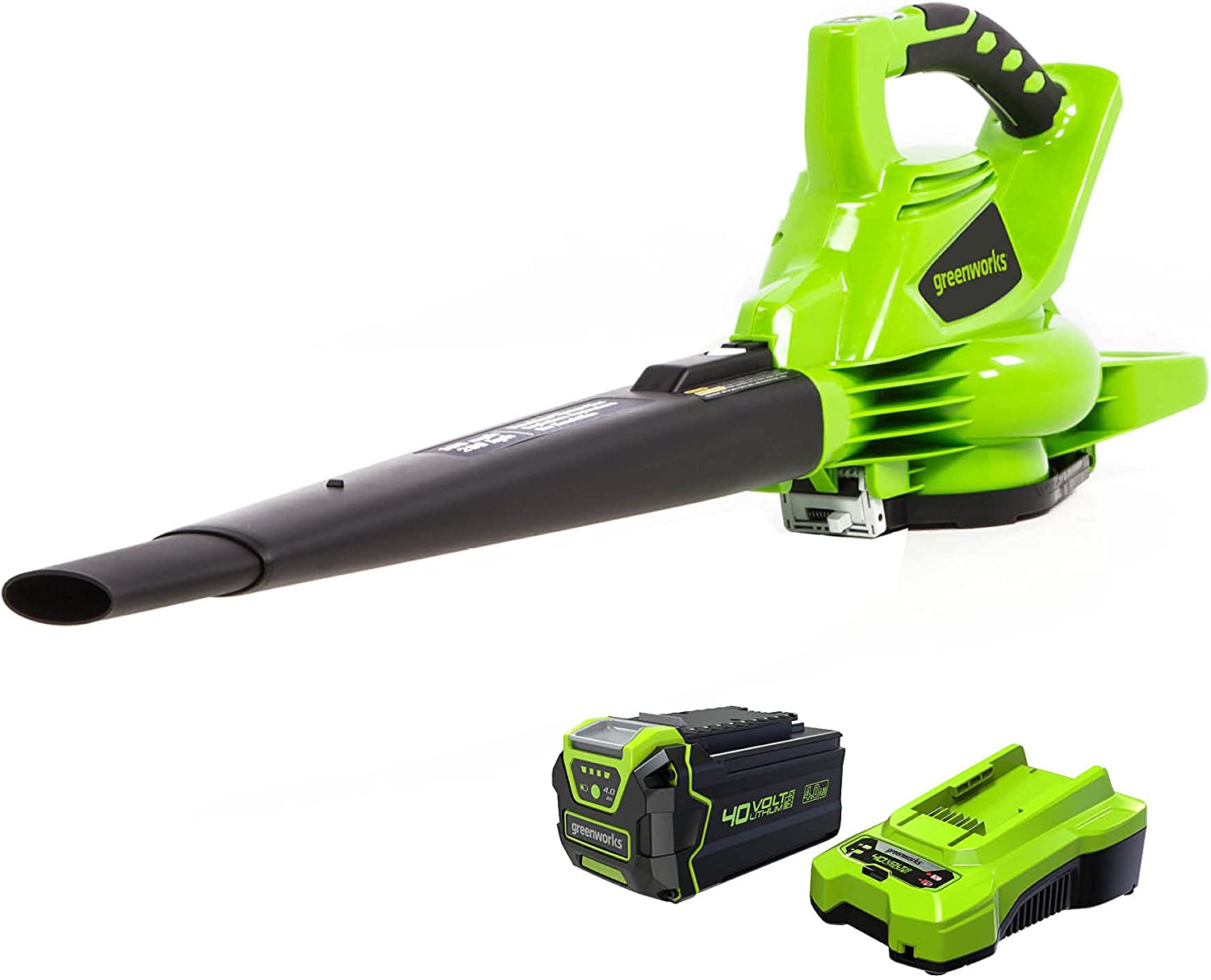
Specifications
| Item Weight | 5.6 Pounds |
| Power Source | Battery Powered |
| Speed | 185 Miles per Hour |
| Air Flow Capacity | 340 Cubic Feet Per Minute |
| Product Dimensions | 32.5 x 8.5 x 11 inches |
The Greenworks cordless leaf blower/vacuum is a multi-tasking machine that has an internal mulching function that breaks up large leaves, grass, small sticks, and other debris into manageable pieces for efficient and compact disposal in the yard bag. You only need to attach the vacuum tube to the bottom of the machine and then insert the bag into the outlet.
The blower is capable of going for about 20 minutes when it is supplied with a fully charged battery, at an airspeed of up to 185 mph, and with a volume of airflow of 340 cubic feet per minute. There are also six different speeds that can be adjusted with this machine by means of the variable speed dial that is located on the handle. With a weight of only 5.6 pounds, it is compact and comes with a 40-volt battery and a battery charger, as well as a vacuum bag for capturing grass and leaves.
In tests conducted on battery-operated blowers, the blower tube is found to be narrower than those in other battery-operated blowers. As a result of this, the airspeed is higher, and the volume is slightly lower. Wet and dry leaves are cleared well by the machine, but it takes a bit of time for it to complete the process. The vac/mulch configuration is only able to cope with the large, stiff, dried leaves of our magnolia tree because the tube is clogged up with the thick dried leaves of the magnolia tree. It does not pose any difficulties for the impeller mechanism to grind them into a fine mulch.
Conclusion
You should take into consideration the demands of the property you are tasked with taking care of when buying a leaf blower. Are there any power outlets available to you? What is the size of your backyard? Do you have a large one or a small one? If you do this, you will be able to determine whether it will be worthwhile to buy a larger gas-powered model or whether you should stick with a corded or wireless model instead.
Following that, consider what type of power tool owner you are. Have you ever considered whether it would be beneficial to maintain the landscaping tools you own, check the engine, or mix the gas in the car? Maybe you just want to connect something to the wall or charge a battery? It is also important to take into account your environment when determining how much power you will need for your project. Do you have any debris other than leaves that you have to deal with? Could the loud engine noise be an issue with your neighbors if you live in a close community?
Defining a price range is an important step for your item after you have reached this conclusion. It is important to remember that the CFM rating of your tool will inform you how many leaves it can move at the same time, and the MPH rating will inform you how fast it can handle heavier debris.
With all these in mind, you are well on your way to finding the best blower.
Download the Best Leaf Blowers PDF
We have made the article available in PDF format in order to make it easier for your future read and reference. By clicking on the link below, you will be able to download the document.
Buy Equipment or Ask for a Service
By using Linquip RFQ Service, you can expect to receive quotations from various suppliers across multiple industries and regions.
Click Here to Request a Quotation From Suppliers and Service Providers
Read More On Linquip
- The 10 Best Snow Blowers + Buying Guide & PDF
- The 10 Best Glues for Metal + Tips for Choosing
- The 10 Best Electric Pressure/Power Washers
- The 10 Best Torque Wrenches + PDF & Buying Guide
- The 8 Best Attic Ladders + Buying Guide & PDF
- The 10 Best Electric Space Heater + Buying Guide
- The 9 Best Cordless Impact Wrenches
- The 7 Best Portable Band Saws + Tips for Choosing
- The 10 Best Hammers
- The 10 Best Circular Saws in the USA
- The 10 Best Mini/Benchtop Milling Machine
- The 8 Best Pressure Washers
- 18 Types of Machining Vises (Clear Guide)
- 8 Types of O-Ring + Applications (Clear Guide)
- The 8 Best Engine Hoists & Accessories + Buying Guide
- Top 10 Irrigation Equipment Suppliers
- Top 10 Railroad Equipment Suppliers in USA & Worldwide
- 8 Best Soldering Iron for Electronics & The Like (Buying Guide)
- The 10 Best Fertilizer Spreader
- The 10 Best Steel Toe Boots for Women
- The 9 Best Commercial Patio Heaters + Buying Guide
- The 10 Best Drywall Anchors + Buying Guide
- The 10 Best Box Cutter/Utility Knife Options



